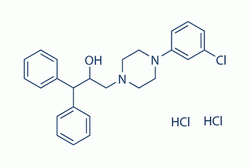| Description: |
BRL-15572 displays high affinity and selectivity For h5-HT1D receptors. BRL-15572 has 60-fold higher affinity For h5-HT1D than 5-HT1B receptors. BRL-15572 binds to h5-HT1B and h5-HT1D receptors with pKB of less than 6 and 7.1, respectively. BRL-15572 stimulates [35S]GTP γ S binding in both cell lines, with potencies that correlated with their receptor binding affinities in both h5-HT1B and h5-HT1D receptor expressing cell lines. BRL-15572 reveals receptor binding affinities For 5-HT1A, 5-HT1B, 5-HT1E, 5-HT1F, 5-HT2A, 5-HT2B, 5-HT2C, 5-HT6 and 5-HT7 with pKi of 7.7, 6.1, 5.2, 6.0, 6.6, 7.4, 6.2, 5.9 and 6.3, respectively. In the h5-HT1D cell line, both BRL-15572 (1 µM) shifts the 5-HT concentration response curve with pKB of 7.1, respectively. BRL-15572 does have moderately high affinity at human 5-HT1A and 5-HT2B receptors. In human atrial appendages, the electrically evoked tritium overflow is inhibited by 5-HT in a manner susceptible to antagonism by BRL-15572 (300 nM; 23 times Ki at h5-HT1D receptors). The inhibitory effect of 5-HT on the K+-evoked overflow of glutamate is antagonized by the h5-HT1D receptor ligand BRL-15572. BRL-15572 (1 μM) is unable to modify the effect of 5-HT at the autoreceptor regulating [3H]5-HT release. The selective 5-HT1D/1B receptor antagonist BRL 15572 inhibits the effect of the agonist L-694 247. For the detailed information of BRL-15572 dihydrochloride, the solubility of BRL-15572 dihydrochloride in water, the solubility of BRL-15572 dihydrochloride in DMSO, the solubility of BRL-15572 dihydrochloride in PBS buffer, the animal experiment (test) of BRL-15572 dihydrochloride, the cell expriment (test) of BRL-15572 dihydrochloride, the in vivo, in vitro and clinical trial test of BRL-15572 dihydrochloride, the EC50, IC50,and Affinity of BRL-15572 dihydrochloride, Please contact DC Chemicals. |

 To enhance service speed and avoid tariff delays, we've opened a US warehouse. All US orders ship directly from our US facility.
To enhance service speed and avoid tariff delays, we've opened a US warehouse. All US orders ship directly from our US facility.




















